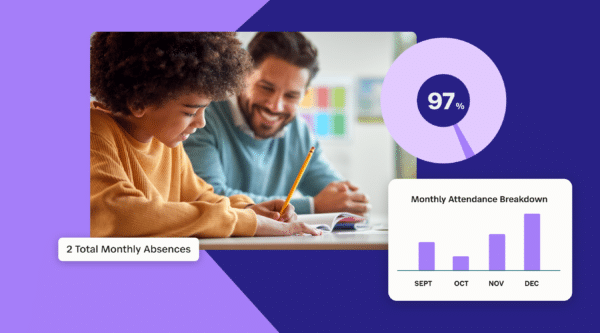

Did you know that students missing just 10% of the school year are 30% less likely to graduate on time? Chronic absenteeism is a widespread challenge that affects not only individual student outcomes but also the overall performance of schools and districts. Tackling this issue requires more than traditional attendance tracking. It demands a data-driven approach that turns insights into actionable strategies.
Let’s explore how advanced analytics can transform attendance tracking, help address chronic absenteeism, and lead to improved student outcomes.
What is Chronic Absenteeism and Why Does it Matter?
Chronic absenteeism refers to students missing 10% or more of the school year, regardless of whether the absences are excused or unexcused. This can equate to missing just two days per month, a small number with a big impact.
Why does it matter? Chronic absenteeism has been linked to lower academic performance, reduced graduation rates, and decreased likelihood of college and career success. Schools with high absenteeism rates often face additional challenges, including funding issues and lower overall achievement metrics.
To address this, educators and administrators must first understand the scope and impact of absenteeism in their own schools and communities. This requires gathering accurate data and engaging stakeholders at every level, from teachers to families. By creating a shared understanding of the issue, schools can begin to implement targeted interventions that have the potential to make a real difference.
The Challenges of Traditional Attendance Tracking
Traditional methods of attendance tracking, such as manual roll calls or outdated spreadsheets, often lead to reactive rather than proactive responses. The reason for this is that these systems:
- Lack real-time data, delaying intervention efforts
- Provide limited insights into attendance trends and root causes
- Fail to identify at-risk students early enough to make an impact
Without the right tools, schools struggle to connect attendance data to actionable strategies, leaving many students behind. For example, a teacher might notice a student’s declining attendance weeks or months after the problem began, when earlier intervention could have prevented further issues. Without a way to analyze attendance patterns, schools are often left guessing at the root causes of absenteeism.
Effective attendance tracking is about more than just compliance. It’s about understanding the story behind the numbers. Schools need tools that not only record data but also provide insights that guide decision-making. This is where advanced analytics come into play.
Advanced Analytics: The Game-Changer in Attendance Tracking
Advanced analytics goes beyond simply recording attendance. It enables schools to:
- Monitor real-time attendance data through dynamic dashboards
- Identify trends, such as recurring absences on specific days
- Detect at-risk students early, allowing for timely interventions
For example, a district using advanced analytics might discover that a specific student group consistently misses Mondays. By identifying this pattern, the school can investigate underlying causes and address them directly. Maybe it’s due to transportation issues, or perhaps families need additional support to prepare for the school week. Advanced analytics make it possible to uncover these stories and take meaningful action.
Another benefit of advanced analytics is the ability to measure the effectiveness of interventions. Schools can track attendance trends before and after implementing a new program or strategy, providing valuable feedback for continuous improvement.
Data-Driven Student Outcomes: Turning Insights into Action
When schools leverage analytics, they can create tailored strategies to improve attendance and student success. Here’s how:
- Personalized Interventions: Use data to identify students most at risk of chronic absenteeism and implement targeted support programs. For example, if analytics show that a student’s attendance begins to decline after a family move, counselors can provide resources to ease the transition.
- Resource Allocation: Analyze patterns to allocate resources, such as counselors or transportation, where they’re needed most. A school might discover that bus routes need adjusting to better accommodate students in a particular neighborhood.
- Family Engagement: Provide parents with actionable attendance insights to foster better communication and support at home. When families see the direct connection between attendance and academic success, they are more likely to prioritize getting their children to school.
For example, Troup County School District improved attendance rates by 25% in just two years by combining data-driven insights with personalized family outreach programs. The district used analytics to create actionable plans that bring families and school leaders together to address attendance issues.
Best Practices for Using Analytics to Improve Attendance
To effectively leverage analytics, schools and districts can follow these actionable steps:
- Implement Real-Time Attendance Tracking Systems: Ensure your data is accurate and up-to-date. Real-time tracking allows schools to respond quickly to emerging trends or issues.
- Set Key Performance Indicators (KPIs): Define measurable goals, such as reducing chronic absenteeism by 10% within the year. Clear KPIs provide a roadmap for success and make it easier to measure progress.
- Train Staff: Equip teachers and administrators with the skills to interpret data and act on insights. Professional development sessions can help educators understand how to use analytics tools and apply their findings effectively.
- Engage Families and Communities: Share attendance data in an accessible format to encourage collaboration. For example, schools can create simple, visually appealing reports that show families how their child’s attendance compares to district averages.
- Create a Culture of Attendance: Celebrate improvements and recognize students with strong attendance records. Positive reinforcement can be a powerful motivator.
To make these steps easier, download our Attendance Tracker Template. This template is provided to help educators and administrators manage attendance and track absenteeism in order to support family engagement and student achievement.
Tools and Strategies to Improve Attendance
To effectively tackle chronic absenteeism, schools and districts need systems that make attendance tracking simple, actionable, and focused on real outcomes for students. Here are some key features and tools that can help:
- Real-Time Attendance Dashboards: Dynamic systems that give schools an immediate view of attendance trends, helping identify areas of concern before they escalate.
- Automated Alerts: Notifications for teachers and administrators about students whose attendance patterns suggest they may need intervention.
- Family Communication Tools: Easy-to-use tools for reaching parents and guardians with timely, relevant information to foster collaboration.
These strategies are built to support educators in their daily efforts, empowering schools to better engage families, allocate resources, and ultimately improve attendance rates. By focusing on data-driven practices, schools can create more equitable learning environments and ensure all students have the opportunity to thrive.
Take Action to Improve Attendance Today
Chronic absenteeism doesn’t have to be an insurmountable challenge. By using advanced analytics and a data-driven approach, schools can not only track attendance but also uncover actionable insights that lead to meaningful change.
Let’s work together to ensure every student has the opportunity to succeed. Turn data into action with SchoolStatus and make a lasting impact on your district’s attendance and student outcomes.
Stay Connected
News, articles, and tips for meeting your district’s goals—delivered to your inbox.





